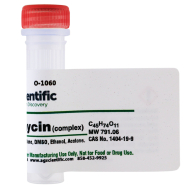When you hear “small things with big impact”, do you immediately think of mitochondria and mitophagy modulators? Probably not! But these little organelles are champions of cell regulation. Among their functions is regulating the energy of the cell as well as cell death. And just as mitochondria are responsible for cell function, mitophagy is responsible for regulating damaged mitochondria.

Researchers who study the process of mitophagy use diseased cell samples to understand how it works. This is often to understand how control of mitophagy can potentially influence curing or preventing disease. At AG Scientific, we stock many forms of high-quality mitophagy modulators for your research! Read on to find out just how important the study of mitophagy is to understanding disease and cell mutation, and the use of reagents in suppressing mitophagy to understand virus transmission - such as that of the Alphacoronavirus. This type of research could prove relevant to the study of COVID-19 and the way it affects the immune system response!
Mitophagy Studies and the Promise of Drug Treatments
As mentioned in a previous blog, cell death occurs in order to maintain the health of an organism. It is imperative that cell death is activated within dysfunctional cells because without it, an organism can develop diseases and disorders. When mitochondria are damaged or starved, one of two types of mitophagy needs to occur to “clean house” - that is, get rid of the dysfunctional mitochondria. The first type of mitophagy pathway is the PINK1/Parkin pathway, which is activated when mitochondria is damaged.
The second type is the PI3K (phosphoinositide 3-kinase) pathway, which is activated when mitochondria is starved of nutrients. Mitophagy, by way of removing damaged mitochondria, also plays an important role in chronic diseases such as Parkinson’s and certain forms of cancer. For example, researchers have deduced that activating mitophagy could inhibit the development of PD (Parkinson’s Disorder) by way of the PINK1/Parkin pathway. Studying the ways in which we can induce and modulate this form of mitophagy could give major headway in creating alternative drug-based treatments for PD. What’s more exciting? This is just one disorder of many we now know could be affected by controlling mitophagy! Further drug treatments are being hypothesized and studied by way of controlling these pathways, whether it is preventing or inducing the mitophagy process.
Reagents Used as Mitophagy Modulators
What happens when mitophagy does not do a sufficient job in ridding the cell of mutated or damaged mitochondria? There is cell dysfunction, metabolic stress, and a decrease in the quality of mitochondria.
As previously mentioned, this leads to cells being especially susceptible to neurodegenerative disease and disorders, like cancer, Alziehmier’s, and diabetes. Therefore scientists use reagents, a list of examples listed below, as mitophagy modulators. Check out our array mitophagy modulators at the bottom of this page! The use of different reagents allows scientists to study mitochondrial proteins and their turnover rates at varying speeds.
Intact-Cell Mitochondrial Stress Test
There are many different methods of influencing mitochondrial function and homeostasis in order to better understand their influence on disease and disorders, such as the intact-cell mitochondrial stress test. Using reagents such as saponin or digitonin to make the cell membrane permeable, without having to use cell disruption, allows researchers to assess the mitochondria functioning within the cell walls. This allows for quality biofeedback from testing the mitochondria and the process of mitophagy.Measuring Mitophagy - Oligomycin and Antimycin
Another example involves using oligomycin combined with antimycin A3 as reagents in order to measure mitophagy. Mitophagy has been studied for a long time using relatively quick and easy methods of experimentation, but in ways that have also been destructive to the quality of cells.
It is increasingly important in modern research to utilize methodologies that use reagents without destructive processes such as the degradation of membrane proteins. New methods allow for the study of mitophagy at its earliest stages without compromising on the integrity of the sample.
Doxycycline Hydrochloride (DOX) and Facilitation of TGEV (Alphacoronavirus)
Some of the most relevant pathology experiments to our current times is the study of viruses and the impacts on their hosts. In the race for a vaccination and better understanding of how the COVID-19 coronavirus strain functions, scientists are experimenting with reagents and their interaction with the virus. Of course, research on virus strains and their effects on cells is nothing new! In 2017, for example, research was conducted on TGEV in pig husbandry using fetal pigs to measure the impact of doxycycline hydrochloride on the immune response to viruses.
Doxycycline hydrochloride is widely used by the meat production industry as an antibiotic via the animals’ nutrition. In fact, DOX is still the most popularly used antibiotic in the meat industry today! However, there is also mounting evidence that mitophagy is an essential process in preserving cell homeostasis during stress due to a virus, and DOX can suppress apoptosis, making way for viral replication in a host. For example, in this particular research study, scientists found that introducing quantities of DOX to a host infected with Alphacoronavirus suppressed the immune response by inhibiting mitophagy, allowing the virus to replicate.

Pathology research like this can provide useful information and cautions for the meat industry. In this case, findings are a cautionary tale in introducing mass amounts of popular antibiotics such as Doxycycline into animals’ diets, due to the fact that viral transmission/replication is easier in a host when they are used. As we look to COVID-19 and the future of our society, research as a preventative measure about the different antibiotics we give to our food sources will grow ever more important.






